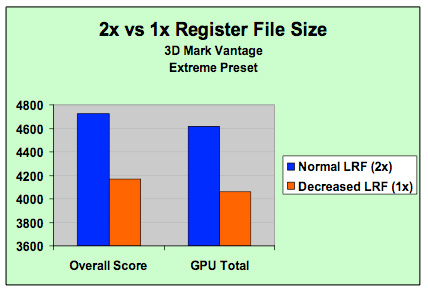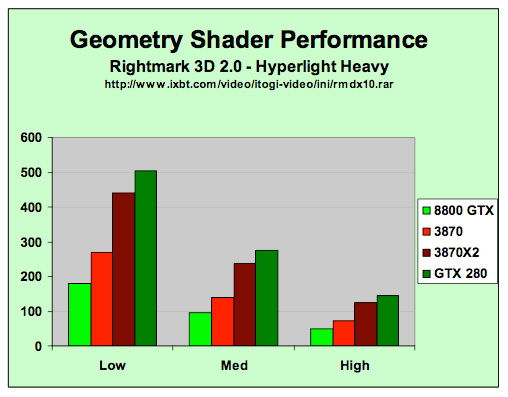NVIDIA's 1.4 Billion Transistor GPU: GT200 Arrives as the GeForce GTX 280 & 260
by Anand Lal Shimpi & Derek Wilson on June 16, 2008 9:00 AM EST- Posted in
- GPUs
Tweaks and Enahancements in GT200
NVIDIA provided us with a list, other than the obvious addition of units and major enhancements in features and technology, of adjustments made from G80 to GT200. These less obvious changes are part of what makes this second generation Tesla architecture a well evolved G80. First up, here's a quick look at percent increases from G80 to GT200.
| NVIDIA Architecture Comparison | 8800 GTX | GTX 280 | % Increase |
| Cores | 128 | 240 | 87.5% |
| Texture | 64t/clk | 80t/clk | 25% |
| ROP Blend | 12p / clk | 32p / clk | 167% |
| Max Precision | fp32 | fp64 | |
| GFLOPs | 518 | 933 | 80% |
| FB Bandwidth | 86 GB/s | 142 GB/s | 65% |
| Texture Fill Rate | 37 GT/s | 48 GT/s | 29.7% |
| ROP Blend Rate | 7 GBL/s | 19 GBLs | 171% |
| PCI Express Bandwidth | 6.4 GB/s | 12.8GB/s | 100% |
| Video Decode | VP1 | VP2 |
Communication between the driver and the front-end hardware has been enhanced through changes to the communications protocol. These changes were designed to help facilitate more efficient data movement between the driver and the hardware. On G80/G92, the front-end could end up in contention with the "data assembler" (input assembler) when performing indexed primitive fetches and forced the hardware to run at less than full speed. This has been fixed with GT200 through some optimizations to the memory crossbar between the assembler and the frame buffer.
The post-transform cache size has been increased. This cache is used to hold transformed vertex and geometry data that is ready for the viewport clip/cull stage, and increasing the size of it has resulted in faster communication and fewer pipeline stalls. Apparently setup rates are similar to G80 at up to one primative per clock, but feeding the setup engine is more efficient with a larger cache.
Z-Cull performance has been improved, while Early-Z rejection rates have increased due to the addition of more ROPs. Per ROP, GT200 can eliminate 32 pixles (or up to 256 samples with 8xAA) per clock.
The most vague improvement we have on the list is this one: "significant micro-architectural improvements in register allocation, instruction scheduling, and instruction issue." These are apparently the improvements that have enabled better "dual-issue" on GT200, but that's still rather vague as to what is actually different. It is mentioned that scheduling between the texture units and SMs within a TPC has also been improved. Again, more detail would be appreciated, but it is at least worth noting that some work went into that area.
Register Files? Double Em!
Each of those itty-bitty SPs is a single-core microprocessor, and as such it has its own register file. As you may remember from our CPU architecture articles, registers are storage areas used to directly feed execution units in a CPU core. A processor's register file is its collection of registers and although we don't know the exact number that were in G80's SPs, we do know that the number has been doubled for GT200.

NVIDIA's own data shows a greater than 10% increase in performance due to the larger register file size (source: NVIDIA)
If NVIDIA is betting that games are going to continue to get more compute intensive, then register file usage should increase as well. More computations means more registers in use, which in turn means that there's a greater likelihood of running out of registers. If a processor runs out of registers, it needs to start swapping data out to much slower memory and performance suffers tremendously.
If you haven't gotten the impression that NVIDIA's GT200 is a compute workhorse, doubling the size of the register file per SP (multiply that by 240 SPs in the chip) should help drive the idea home.
Double the Precision, 1/8th the Performance
Another major feature of the GT200 GPU and cards based on it is support for hardware double precision floating point operations. Double precision FP operations are 64-bits wide vs. 32-bit for single precision FP operations.
Now the 240 SPs in GT200 are single-precision only, they simply can't accept 64-bit operations at all. In order to add hardware level double precision NVIDIA actually includes one double precision unit per shading multiprocessor, for a total of 30 double precision units across the entire chip.
The ratio of double precision to single precision hardware in GT200 is ridiculously low, to the point that it's mostly useless for graphics rasterization. It is however, useful for scientific computing and other GPGPU applications.
It's unlikely that 3D games will make use of double precision FP extensively, especially given that 8-bit integer and 16-bit floating point are still used in many shader programs today. If anything, we'll see the use of DP FP operations in geometry and vertex operations first, before we ever need that sort of precision for color - much like how the transition to single precision FP started first in vertex shaders before eventually gaining support throughout the 3D pipeline.
Geometry Wars
ATI's R600 is alright at geometry shading. So is RV670. G80 didn't really keep up in this area. Of course, games haven't really made extensive use of geometry shaders because neither AMD nor NVIDIA offered compelling performance and other techniques made more efficient use of the hardware. This has worked out well for NVIDIA so far, but they couldn't ignore the issue forever.
GT200 has enhanced geometry shading support over G80 and is now on par with what we wish we had seen last year. We can't fault NVIDIA too much as with such divergent new features they had to try and predict the usage models that developers might be interested in years in advance. Now that we are here and can see what developers want to do with geometry shading, it makes sense to enhance the hardware in ways that support these efforts.

GT200 has significantly improved geometry shader performance compared to G80 (source: NVIDIA)
Generation of vertex data is a particularly weak part of NVIDIA's G80, so GT200 is capable of streaming out 6x the data of G80. Of course there are the scheduling enhancements that affect everything, but it is unclear as to whether NVIDIA did anything beyond increasing the size of their internal output buffers by 6x in order to enhance their geometry shading capability. Certainly this was lacking previously, but hopefully this will make heavy use of the geometry shader something developers are both interested in and can take advantage of.










108 Comments
View All Comments
gigahertz20 - Monday, June 16, 2008 - link
I think these ridiculous prices and lackluster performance is just a way for them to sell more SLI motherboards, who would buy a $650 GTX 280 when you can buy two 8800GT's with a SLI mobo and get better performance? Especially now that the 8800GT's are approaching around $150.crimson117 - Monday, June 16, 2008 - link
It's only worth riding the bleeding edge when you can afford to stay there with every release. Otherwise, 12 months down the line, you have no budget left for an upgrade, while everyone else is buying new $200 cards that beat your old $600 card.So yeah you can buy an 8800GT or two right now, and you and me should probably do just that! But Richie Rich will be buying 2x GTX 280's, and by the time we could afford even one of those, he'll already have ordered a pair of whatever $600 cards are coming out next.
7Enigma - Tuesday, June 17, 2008 - link
Nope, the majority of these cards go to Alienware/Falcon/etc. top of the line, overpriced pre-built systems. These are for the people that blow $5k on a system every couple years, don't upgrade, might not even seriously game, they just want the best TODAY.They are the ones that blindly check the bottom box in every configuration for the "fastest" computer money can buy.
gigahertz20 - Monday, June 16, 2008 - link
Very few people are richie rich and stay at the bleeding edge. People that are very wealthy tend not to be computer geeks and purchase their computers from Dell and what not. I'd say at least 96% of gamers out there are value oriented, these $650 cards will not sell much at all. If anything, you'll see people claim to have bought one or two of these in forums and other places, but their just lying.perzy - Monday, June 16, 2008 - link
Well I for one is waiting for Larabee. Maybee (probably) it isen' all that its cranked up to be, but I want to see.And what about some real powersaving Nvidia?
can - Monday, June 16, 2008 - link
I wonder if you can just flash the BIOS of the 260 to get it to operate as if it were a 280...7Enigma - Tuesday, June 17, 2008 - link
You haven't been able to do this for a long time....they learned their lessons the hard way. :)Nighteye2 - Monday, June 16, 2008 - link
Is it just me, or does this focus on compute power mean Nvidia is starting to get serious about using the GPU for physics, as well as graphics? It's also in-line with the Ageia acquisition.will889 - Monday, June 16, 2008 - link
At the point where NV has actually managed to position SLI mobos and GPU's where you actually need that much power to get decent FPS (above 30 average) from games gaming on the PC will be entirely dead to all those but the most esoteric. It would be different if there were any games worth playing or as many games as the console brethren have. I thought GPU's/cases/power supplies were supposed to become more efficient? EG smaller but faster sort of how the TV industry made TV's bigger yet smaller in footprint with way more features - not towering cases with 1200KW PSU's and 2X GTX 280 GPU's? All this in the face o drastically raised gas prices?Wanna impress me? How about a single GPU with the PCB size of a 7600GT/GS that's 15-25% faster than a 9800GTX that can fit into a SFF case? needing a small power supply AND able to run passively @ moderate temps. THAT would be impressive. No, Seargent Tom and his TONKA_TRUCK crew just have to show how beefy his toys can be and yank your wallet chains for said. Hell, everyone needs a Boeing 747 in their case right? cause' that's progress for those 1-2 gaming titles per years that give you 3-4 hours of enjoyable PC gaming.....
/off box
ChronoReverse - Tuesday, June 17, 2008 - link
The 4850 might actually hit that target...